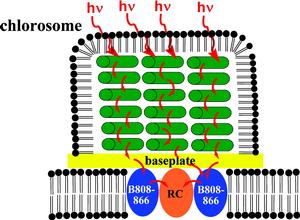
Structural studies of some of nature’s most efficient light-harvesting systems are lighting the way for new generations of biologically inspired solar cell devices.
Researchers from Washington University in St. Louis and the Department of Energy’s Oak Ridge National Laboratory used small-angle neutron scattering to analyze the structure of chlorosomes in green photosynthetic bacteria. Chlorosomes are efficient at collecting sunlight for conversion to energy, even in low-light and extreme environments.
“It’s one of the most efficient light harvesting antenna complexes found in nature,” said co-author and research scientist Volker Urban of ORNL’s Center for Structural Molecular Biology, or CSMB.
Neutron analysis performed at the CSMB’s Bio-SANS instrument at the High Flux Isotope Reactor allowed the team to examine chlorosome structure under a range of thermal and ionic conditions.
“We found that their structure changed very little under all these conditions, which shows them to be very stable,” Urban said. “This is important for potential biohybrid applications – if you wanted to use them to harvest light in synthetic materials like a hybrid solar cell, for example.”
The size, shape and organization of light-harvesting complexes such as chlorosomes are critical factors in electron transfer to semiconductor electrodes in solar devices. Understanding how chlorosomes function in nature could help scientists mimic the chlorosome’s efficiency to create robust biohybrid or bio-inspired solar cells.
“What’s so amazing about the chlorosome is that this large and complicated assembly is able to capture light effectively across a large area and then funnel the light to the reaction center without losing it along the way,” Urban said. “Why this works so well in chlorosomes is not well understood at all.”
“We’re trying to find out general principles that are important for capturing, harvesting and transporting light efficiently and see how nature has solved that,” Urban said.
Small-angle neutron scattering enabled the team to clearly observe the complicated biological systems at a nanoscale level without damaging the samples.
“With neutrons, you have an advantage that you get a very sharp contrast between these two phases, the chlorosome and the deuterated buffer. This gives you something like a clear black and white image,” Urban said.
The team, led by Robert Blankenship of Washington University, published its findings in the journal Langmuir. The research was supported through the Photosynthetic Antenna Research Center, an Energy Frontier Research Center funded by DOE’s Office of Science. Both HFIR and the Bio-SANS facility at ORNL’s Center for Structural Molecular Biology are also supported by DOE’s Office of Science.



